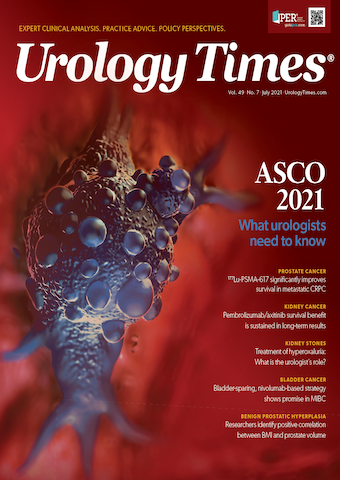Publication
Article
Urology Times Journal
Hyperoxaluria: What is the urologist’s role in diagnosis and treatment?
Author(s):
Roughly 1 in 10 Americans will have a kidney stone during their lifetime, according to the Urology Care Foundation Kidney Stones Patient Guide. A contributing factor to kidney stones is hyperoxaluria, for which the treatment lumasiran (Oxlumo) was recently approved by FDA, and other treatments are in the pipeline. In an interview with Urology Times®, Kyle Wood, MD, an assistant professor of urology at the University of Alabama, Birmingham, discussed the different types of hyperoxaluria, the urologist’s role in managing the condition, and the treatments for it.
What is hyperoxaluria, and are there different types?
To answer those questions, it's important to understand where oxalate is derived from. Oxalate has both a dietary and an endogenous source. Dietary oxalate comes mostly from food sources that grow in the ground. With endogenous oxalate, the body creates oxalate as an end metabolite and oxalate is then excreted in urine. The presumed major source of oxalate has always been the liver, but other organs may also play a role. There are different definitions of hyperoxaluria, but it is usually defined as greater than 40 or 45 mg per day of urinary oxalate excretion.
In its simplest form, [hyperoxaluria] is broken out into primary and secondary hyperoxaluria. Primary hyperoxaluria has known monogenetic conditions that cause the increased oxalate and is currently broken out into 3 known types—PH1, PH2, and PH3. Each corresponds to a specific gene, [and] each of the genes codes for a protein involved in the endogenous oxalate pathway. PH1 is the most common and severe form, representing close to 70% of the known cases of primary hyperoxaluria. Historically, many of these patients were treated with liver-kidney transplant. PH2 and PH3 are less common and less severe but still can result in recurrent kidney stones, nephrocalcinosis, and renal failure.
Secondary hyperoxalurias can be characterized as either dietary indiscretion or enteric. Dietary indiscretion-related hyperoxaluria occurs when patients consume too much oxalate and thus absorb and excrete too much oxalate. This subtype benefits from dietary restriction. Enteric hyperoxaluria results from increased uptake of oxalate from the gastrointestinal tract and usually results because of malabsorptive processes, such as bowel surgery.
Finally, there is idiopathic hyperoxaluria. This classification is reserved for those that have an unknown cause to explain the hyperoxaluria. Presumably, the heightened oxalate excretion is derived from the endogenous pathway, some altered handling of oxalate, dietary indiscretion, or some other unknown source.
In November 2020, the FDA approved lumasiran for the treatment of PH1. How does this medication work?
Lumasiran addresses and is approved to treat PH1. It uses RNA interference technology, which binds to specific messenger RNA and prevents the protein/enzyme from being translated. GalNAc [N-Acetylgalactosamine]-siRNA [small interfering RNA] conjugates are liver specific and thus can target the endogenous oxalate pathway. Lumasiran targets glycolate oxidase, which is an enzyme involved in the conversion of glycolate to glyoxylate. Glyoxylate is the main precursor to oxalate and thus, by reducing the creation of glyoxylate, there is less oxalate production. It is delivered subcutaneously and has been approved for PH1 in children and adults.
Can you discuss the key findings from the pivotal phase 3 ILLUMINATE-A trial (NCT03681184) of lumasiran?
ILLUMINATE-A was a study of 39 adult and pediatric patients [6 years and older] who had a diagnosis of PH1. [These patients] did not have severe kidney damage and were not on dialysis. Twenty-six patients received lumasiran subcutaneously, and this was compared with 13 patients that received placebo. All patients were followed for 6 months with an extension arm. The primary end point was urinary oxalate excretion. Those patients who received lumasiran had a 53% reduction in urinary oxalate excretion compared with placebo (highly significant). Further, 84% of the patients receiving lumasiran had normalization or near normalization (defined as less than 1.5 times above the normal range).
What is the practicing urologist's role in the treatment of hyperoxaluria?
Hyperoxaluria can be one of the many contributing factors to stone disease. When we’re talking about primary hyperoxaluria, I think the role of the urologist is to help diagnose [the disease in] these individuals. Diagnosis and treatment of primary hyperoxaluria can be life-changing for the patient. In regard to secondary hyperoxaluria, it is important for the urologist to diagnose and treat as well, as this can reduce the stone risk and other sequelae of hyperoxaluria. As urologists, we need to determine the cause of the hyperoxaluria. For example, if it is dietary indiscretion, we need to give sound dietary advice. Determining the underlying cause of hyperoxaluria becomes important. For [instance], if a patient has enteric hyperoxaluria, the urologist, knowing the pathophysiology, may give specific dietary advice, begin medical management, and potentially involve other specialty services.
Three other treatments—nedosiran, reloxaliase, and Oxabact—are being investigated for hyperoxaluria. What is their status? If approved, how would they differ from lumasiran?
Lumasiran addresses the endogenous production of oxalate and is only used in PH1. Nedosiran, which is being developed by Dicerna and is in phase 3 [clinical] trials, uses GalNAc-siRNA technology similar to lumasiran but targets liver lactate dehydrogenase. Lactate dehydrogenase is the final enzyme and converts glyoxylate to oxalate. If approved, nedosiran could be used to treat PH1, PH2, and PH3.
Reloxaliase is an crystalline formulation of the enzyme, oxalate decarboxylase, which breaks down oxalate. It specifically breaks down oxalate in the gastrointestinal tract and is being studied in enteric hyperoxaluria. In the URIROX-1 phase 3 study, 115 patients with enteric hyperoxaluria were randomized to reloxaliase or placebo. Those receiving reloxaliase had a 22.6% reduction in urinary oxalate excretion compared with the 9.7% reduction in the placebo group. Reloxaliase is taken with meals and snacks and requires multiple doses per day. Further studies are being performed to determine if reloxaliase treatment translates into reduced clinical stone events.
Oxabact uses the understanding of Oxalobacter formigenes, [which] is a bacteria that uses oxalate as its energy source. Oxabact degrades gastrointestinal oxalate and is being studied in primary hyperoxaluria.
Lumasiran will be used in the PH1 population, whereas nedosiran is being studied in all known types of primary hyperoxaluria. Reloxaliase is being studied in enteric hyperoxaluria, and Oxabact is being studied in the primary hyperoxaluria population. Whether these treatments will have a role in other types of hyperoxaluria is certainly of interest and will require future research studies.
























